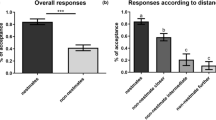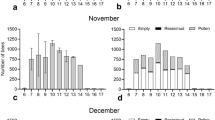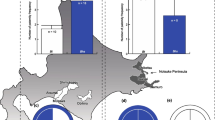Summary
Behavioural differentiation in honey bee workers has been the most important issue in papers on honey bee behaviour throughout the years. However, little is yet known about proximate factors leading to behavioural differentiation within worker honey bees of the same age group (idiosyncrasy). Although recently there have been many publications concerning the influence of genetic and physiological factors on worker behaviour, these factors do not provide proximate clues at the level of an individual. The aim of this paper is to describe behavioural differentiation within one age group of honey bee workers. These descriptions for more or less normal situations are necessary in order to make investigations with respect to the proximate factors leading to idiosyncrasy possible. Various methods have to be employed to describe and quantify these differences. The analysis of frequency distributions of involvement in a behaviour alone is usually not enough for this purpose.
Significant idiosyncrasy has been found for “comb construction”, “allogrooming” and some behavioural acts which occur in queenless colonies: “involvement in aggressive interactions” (both as “aggressor” and as “victim”) and “staying in empty cells”. The distribution of the number of times workers were allogroomed never deviated from random distributions. Also workers' “involvement in visiting larvae in emergency queen cells” was mostly random.
Similar content being viewed by others
References
Abraham, M., J. L. Deneubourg and J. M. Pasteels, 1984. Idiosyncrasie lors du déménagement deMyrmica rubra (Hymenoptera, Formicidae).Actes Coll. Insectes Soc. 1:19–25.
Blom, J. van der, 1990. Division of labour within one age group of honey bee workers (Apis mellifera).Actes Coll. Insectes Soc. 6:139–145.
Blom, J. van der, 1991. Social regulation of egg-laying by queenless honey bee workers (Apis mellifera L.).Behav. Ecol. Sociobiol. 29:341–346.
Blom, J. van der, 1992. An analysis of queen attending by worker honey bees.Ins. Soc. 39:237–249.
Blom, J. van der, 1993. “Division of labour” in honeybees: a revision.Proc. Exper. & Appl. N.E.V. 4:91–96.
Beetsma, J. and A. ten Houten, 1974. Effects of juvenile hormone analogues in the food of honey bee colonies.Z. angew. Entomol. 77:292–300.
Calderone, N. W. and R. E. Page, 1991. Evolutionary genetics of division of labor in colonies of the honey bee (Apis mellifera).Am. Nat. 138:69–92.
Deneubourgh, J. -L., S. Goss, J. M. Pasteels, D. Fresneau and J. -P. Lachaud, 1987. Self organisation mechanisms in ant societies (II): learning and foraging in division of labour. In: Pasteels, J. M. and Deneubourgh, J. -L. (Eds.):From individual to collective behaviour in social insects. Experientia (Suppl.) 54:177–196.
Fergusson, L. A. and M. L. Winston, 1987. The influence of wax deprivation on temporal polyethism in honey bee (Apis mellifera L.) colonies.Can. J. Zool. 66:1997–2001.
Fluri, P., M. Lüscher, H. Wille and L. Gerig, 1982. Changes in weight of the pharyngeal gland and haemolymph titers of juvenile hormone, protein and vitellogenin in worker honey bees.J. Insect Physiol. 28:61–68.
Frisch, K. von, 1965.Tanzsprache und Orientierung der Bienen. Springer Verlag, Berlin, Heidelberg, New York.
Heinrich, B., 1979.Bumblebee economics. Cambridge, MA: Harvard Univ. Press.
Hogeweg, P. and B. Hesper, 1981. The ontogeny of the interaction structure in bumble bee colonies: a MIRROR model.Behav. Ecol. Sociobiol 12:271–283.
Jaycox, E. R., 1976. Behavioral changes in worker honey bees (Apis mellifera L.) after injection with synthetic juvenile hormone (Hymenoptera, Apidae).J. Kansas Entomol. Soc. 49:165–170.
Jaycox, E. R., W. Skowronek, G. Gwynn, 1974. Behavioral changes in worker honey bees (Apis mellifera L.) induced by injections of a juvenile hormone mimic.Ann. Entomol. Soc. Am. 67:529–534.
Jeanne, R. L. (Ed.), 1988.Interindividual behavioral variability in social insects. Westview Press, Boulder & London.
Kolmes, S. A., 1985. A quantitative study of the division of labour among worker honey bees.Z. Tierpsychol. 68:287–302.
Kolmes, S. A., 1989. Grooming specialists among worker honey bees.Apis mellifera. Anim. Behav. 37:1048–1049.
Kolmes, S. A., 1990. Recent progress in the study of adaptive behavioural flexibility in honey bees.Bee World 71:122–129.
Lee, E. T., 1980.Statistical methods for survival data analysis. Lifetime learning publications. Belmont, California, U.S.A.
Lenoir, A., 1987. Factors determining polyethism in social insects. In: J. M. Pasteels and J. -L. Deneubourgh (Eds.):From individual to collective behavior in social insects. Experientia (Suppl.) 54:219–241.
Lindauer, M., 1952. Ein Beitrag zur Arbeitsteilung im Bienenstaat.Z. verg. Physiol. 34:299–345.
Lindsey, J. K., 1989. The analysis of categorical data using GLIM.Lecture notes in statistics 56:1–168.
Menzel, R., 1985. Learning in honey bees in an ecological and behavioral context. In: B. Hölldobler and M. Lindauer (Eds.)Experimental and behavioural ecology and sociobiology. Sunderland MA: Sinauer Associates.
Michener, C. D., 1974.The social behaviour of the bees: a comparative study. Belknap/Harvard Univ. Press, Cambridge MA.
Moore, A. J., M. D. Breed and M. J. Moor, 1987. The guard honey bee: ontogeny and behavioural variability of workers performing a specialized task.Anim. Behav. 35:1159–1167.
Page, R. E. and G. E. Robinson, 1991. The genetics of division of labour in honey bee colonies.Adv. Insect Physiol. 33:117–169.
Pasteels, J. M. and J. -L. Deneubourgh (Eds.), 1987:From individual to collective behaviour in social insects. Experientia (Suppl) 54.
Plowright, R. C. and C. M. S. Plowright, 1988. Elitism in social insects: a positive feedback model. In: Jeanne, R. L. (Ed.), 1988.Interindividual behavioral variability in social insects. Westview Press, Boulder & London.
Robinson, G. E., 1987. Regulation of honey bee age polyethism by juvenile hormone.Behav. Ecol. Sociobiol. 20:329–338.
Robinson, G. E., 1992. Regulation of division of labor in insect societies.Annu. Rev. Entomol. 37:637–665.
Robinson, G. E., R. E. Page, C. Strambi, A. Strambi, 1989. Hormonal and genetic control of behavioural integration in honey bee colonies.Science 246:109–112.
Rösch, G. A., 1925. Untersuchungen über die Arbeitsteilung im Bienenstaat, I. Teil: Die Tätigkeiten im normalen Bienenstaate und ihre Beziehung zum Alter der Arbeitsbienen.Z. verg. Physiol. 2:571–631.
Rösch, G. A., 1930. Untersuchungen über die Arbeitsteilung im Bienenstaat, II. Teil: Die Tätigkeiten der Arbeitsbienen unter experimentell veränderten Bedingungen.Z. verg. Physiol. 12:1–71.
Rutz, W., L. Gerig, H. Wille and M. Lüscher, 1974. A bioassay for juvenile hormone (JH) effects of insect growth regulators (IGR) on adult worker honey bees.Mitt. Schweiz. Entomol. Ges. 47:307–313.
Rutz, W., L. Gerig, H. Wille and M. Lüscher, 1976. The function of juvenile hormone in adult worker honey bees,Apis mellifera.J. Insect Physiol. 22:1485–1491.
Sakagami, S. F., 1953. Untersuchungen über die Arbeitsteilung in einem Zwergvolk der Honigbiene: Beiträge zur Biologie des Bienenvolkes,Apis mellifera L.Jap. J. Zool. 11:117–185.
Seeley, T. D. and S. A. Kolmes, 1991. Age polyethism for hive duties in honey bees — illusion or reality?Ethology 87:284–297.
Seeley, T. D., 1982. Adaptive significance of the age polyethism schedule in honey bee colonies.Behav. Ecol. Sociobiol. 11:287–293.
Visscher, P. K., 1983. The honey bee way of death: necrophoric behaviour inApis mellifera colonies.Anim. Behav. 31:1070–1076.
Wiley, R. H., 1981. Social structure and individual ontogenies: problems of description, mechanisms and evolution.Perspectives in Ethology 4:105–133.
Winston, M. L., 1987.The biology of the honey bee. Cambridge (Massachusetts): Harvard University Press.
Winston, M. L. and L. A. Fergusson, 1985. The effect of worker loss on temporal caste structure in colonies of the honey bee (Apis mellifera L.).Can. J. Zool. 63:777–780.
Winston, M. L. and L. A. Fergusson, 1986. The influence of the amount of eggs and larvae in honey bee (Apis mellifera L.) colonies on temporal division of labor.J. Apic. Res. 25:238–241.
Winston, M. L. and E. N. Punnett, 1982. Factors determining temporal division of labor in honey bees.Can. J. Zool. 60:2947–2952.
Author information
Authors and Affiliations
Rights and permissions
About this article
Cite this article
van der Blom, J. Individual differentiation in behaviour of honey bee workers (Apis meltifera L.). Ins. Soc 40, 345–361 (1993). https://doi.org/10.1007/BF01253898
Received:
Revised:
Accepted:
Issue Date:
DOI: https://doi.org/10.1007/BF01253898




